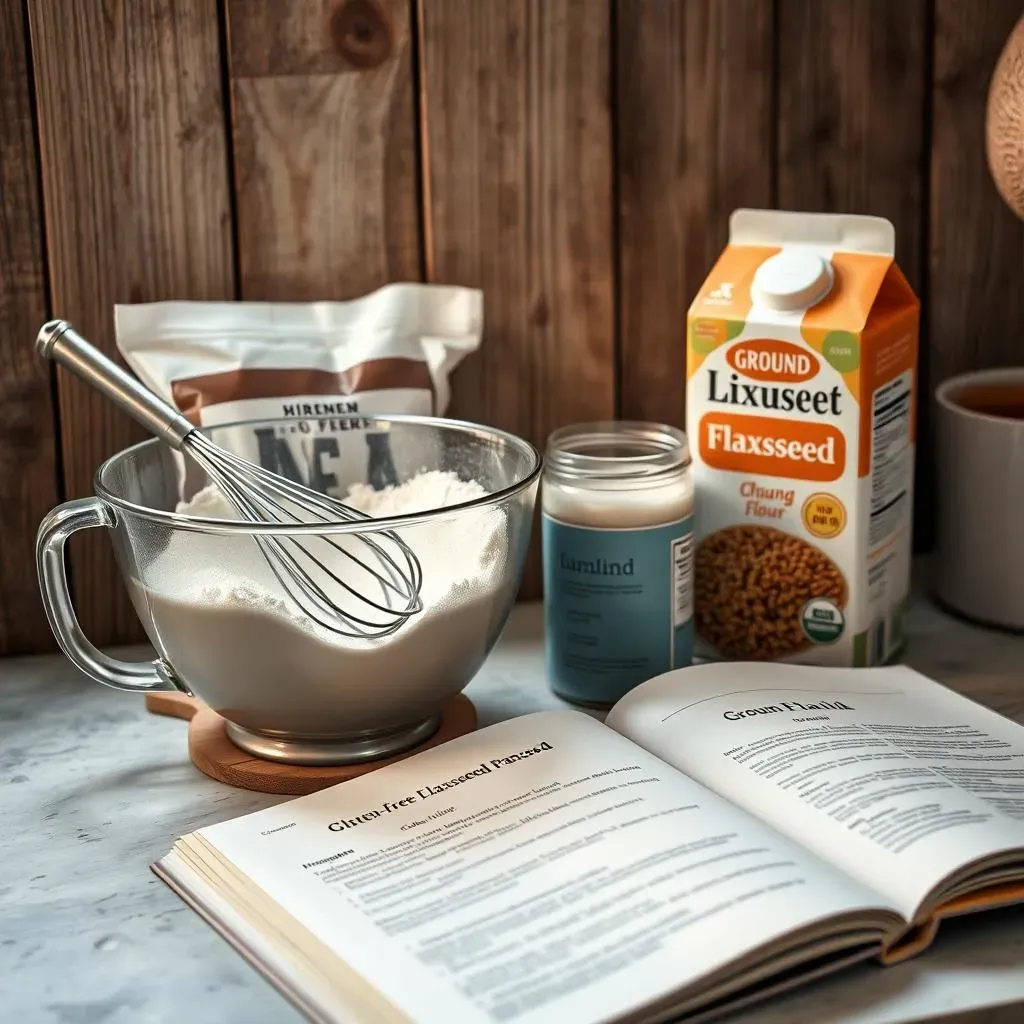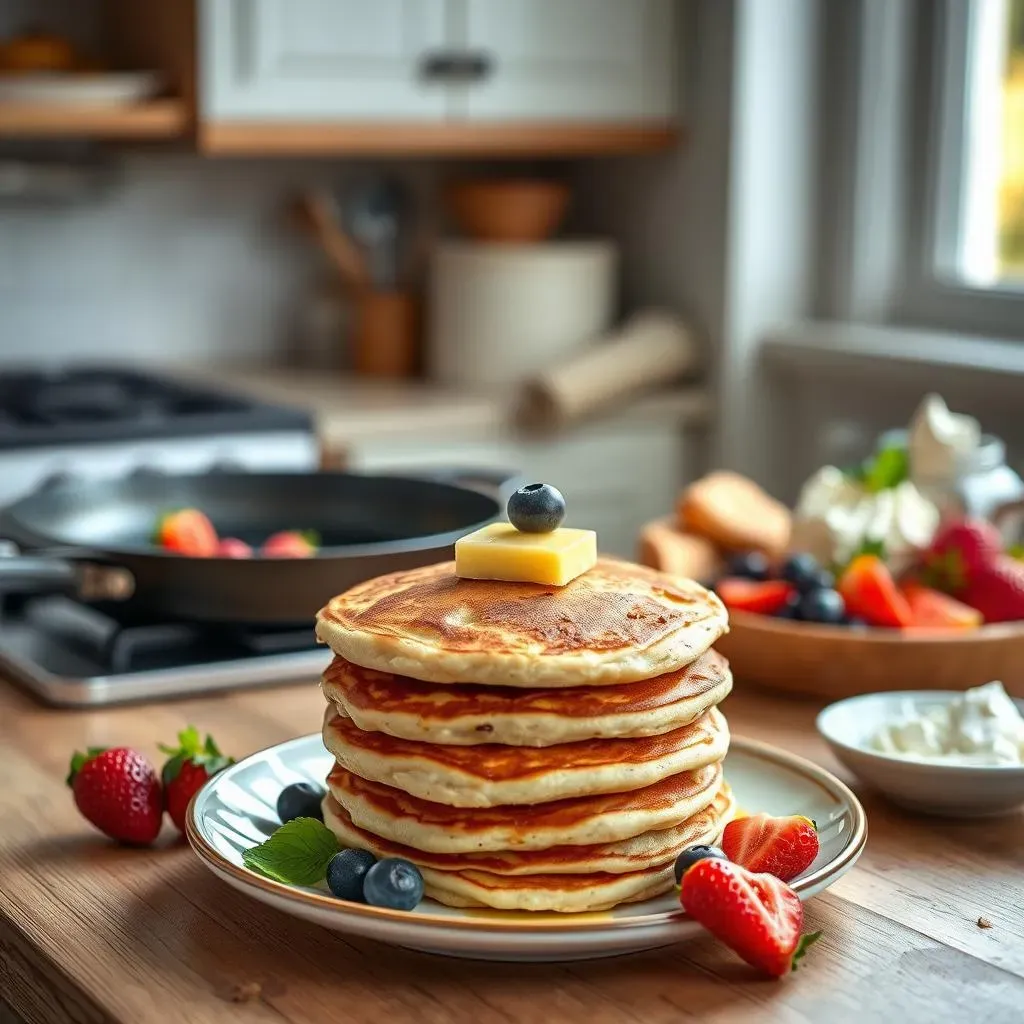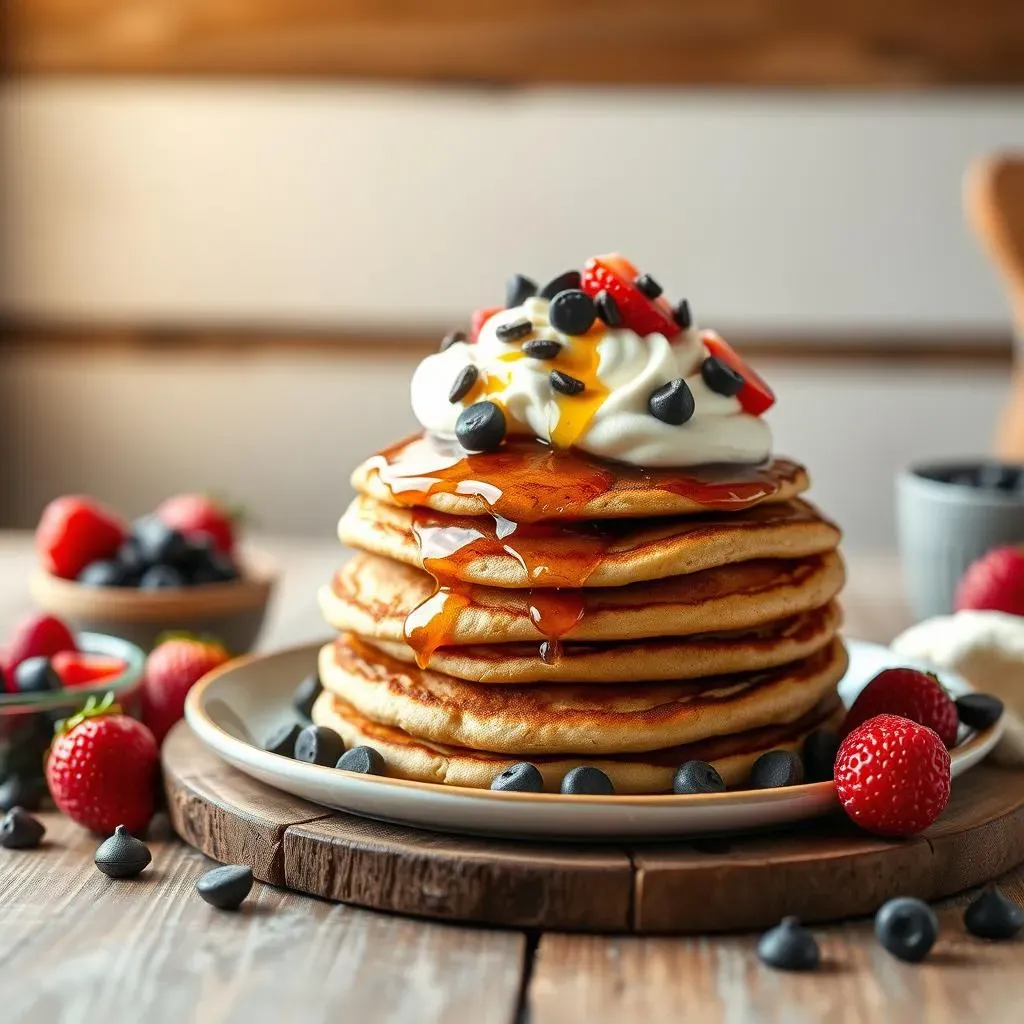Table of Contents
Ever dreamt of a breakfast that's both delicious and good for you? If you're navigating the world of gluten-free eating, finding the perfect pancake can feel like searching for a unicorn. But what if I told you that the secret to fluffy, satisfying, and totally gluten-free pancakes lies in a tiny seed? Yes, I'm talking about flaxseed! This isn't your average breakfast; it's a game-changer. We're about to explore a fantastic gluten-free pancake recipe with flaxseed meal that'll not only meet your dietary needs but also tantalize your taste buds. We'll start by uncovering why flaxseed is a breakfast superhero, then we'll dive into creating the ideal batter. Next, we'll master the art of cooking these golden beauties, and finally, we’ll talk about serving suggestions, storage solutions, and ingredient swaps. So, get your spatulas ready, and let's flip some amazing pancakes together!
Why Flaxseed is a Pancake Game Changer
Why Flaxseed is a Pancake Game Changer
Okay, so you might be thinking, "Flaxseed? In pancakes?" I get it. It sounds a bit… granola. But trust me, these tiny seeds are like the secret agents of the breakfast world, especially when you're aiming for gluten-free perfection. They're not just some health fad; they actually bring a whole lot to the pancake party. First off, they act as a binder. Gluten, the stuff that gives regular pancakes their structure, is out of the picture here, right? Flaxseed steps in with its magic, creating a lovely, cohesive batter. It’s like the glue that holds it all together, preventing your pancakes from crumbling into a sad, shapeless mess.
Beyond just structure, flaxseed also adds a wonderful, slightly nutty flavor. It's subtle, but it elevates the whole pancake experience. Plus, it’s packed with fiber and omega-3 fatty acids, which means your breakfast is not just tasty, but actually good for you. It's like sneaking in a health boost without even trying too hard. Forget those sad, dense gluten-free attempts you may have had before. With flaxseed, you get a soft, almost pillowy texture that's hard to resist. If you are new to gluten-free, then check out this easy gluten-free recipe.
Now, you might be wondering, "Okay, but how do I even use them?" Don't worry, it's super simple. You can buy flaxseed meal pre-ground, or you can grind whole flaxseeds yourself using a food processor or even a coffee grinder. Just a little bit goes a long way, and it makes all the difference in creating a gluten-free pancake that's actually worth getting out of bed for. It's truly amazing the difference a small addition can make, and if you're looking for more ways to use different flours, check out this blend of flours pancake recipe. Seriously, once you try it, you’ll be asking yourself why you weren't using flaxseed in your pancakes all along.
Flaxseed Benefit | Why It Matters for Pancakes |
|---|---|
Acts as a binder | Holds the batter together without gluten |
Adds a nutty flavor | Enhances the overall taste |
Rich in fiber and omega-3 | Makes your breakfast healthier |
Improves texture | Creates soft, pillowy pancakes |
Crafting the Perfect GlutenFree Flaxseed Batter
Crafting the Perfect GlutenFree Flaxseed Batter
The Foundation
: Getting Your Dry Ingredients Right
Okay, so we've hyped up flaxseed, now let's talk about making that batter. It's not just about throwing everything in a bowl and hoping for the best; there's a bit of a science to it, especially when you're going gluten-free. First, let’s gather our dry ingredients. Think of it like building a house; the foundation needs to be solid. For the gluten-free flour, you have options. You can use a pre-made gluten-free blend, which is super convenient, or you can create your own mix. I like to use a combination of rice flour, tapioca starch, and maybe a bit of almond flour if I'm feeling fancy. You can also try this fluffy gluten-free recipe using almond flour to see how the texture changes.
Then, you can't forget the leavening agents. Baking powder and baking soda are your friends here. They’re what gives your pancakes that lovely lift and fluffiness. Don't skimp on these! And of course, the star of the show: flaxseed meal. Remember, if you're grinding your own flaxseeds, make sure it's a fine powder. Lumps can mess with the texture of your batter. Also, add a pinch of salt, it helps to enhance the flavors. Once you have all your dry ingredients together, whisk them really well. This ensures everything is evenly distributed, which is crucial for a consistent pancake.
Before we move on, let's quickly recap. We’re aiming for a well-balanced mix of gluten-free flour, leavening agents, and flaxseed meal, all whisked together like you mean it. Think of it as a well-rehearsed dance. Every ingredient has its part to play. And don't worry if you don't have all the flours I mentioned, check this gluten-free pancake recipe comparison to see what works best for you. Now that we have our solid foundation, let's move on to the wet ingredients.
- Gluten-Free Flour: Use a blend or your own mix.
- Leavening Agents: Baking powder and baking soda are key.
- Flaxseed Meal: Finely ground for best results.
- Salt: Just a pinch for flavor enhancement.
The Liquid Magic
: Combining Wet Ingredients
Now, onto the wet ingredients. This is where things get a little more exciting. You'll need some kind of plant-based milk. Almond milk, soy milk, oat milk—they all work great. Pick your favorite, or whatever you have on hand. I've noticed that oat milk gives the pancakes a slightly creamier texture, but it's all about preference. Also, you will need a touch of sweetness. Maple syrup is my go-to, but you can also use agave or honey. If you're trying to keep it low-sugar, you can use a sugar-free alternative or even just a splash of vanilla extract for flavor. A little bit of apple cider vinegar reacts with the baking soda to help make the pancakes extra fluffy. It's a small touch, but it makes a big difference.
Combine your wet ingredients in a separate bowl, whisking them well. This ensures that your milk, sweetener, and vinegar are all working together harmoniously. Then, and this is important, gently pour the wet ingredients into the dry ingredients. Don’t just dump it all in at once. Mix until just combined. You want to avoid overmixing. Overmixing can make your pancakes tough, and we definitely don't want that. It's like trying to fold a fitted sheet; it's all about gentle movements. If you're looking for another option, this plant-based milk pancake recipe is another good one to try out.
One more important thing, after you’ve mixed the batter, let it sit for about five minutes. This allows the flaxseed to absorb some of the liquid, which will give your pancakes a better texture. It's like letting your dough rest before baking a pizza. It's a small step that makes a big difference. Now, you might be thinking all of this is a lot of work but trust me, it’s not. It’s a simple recipe, and once you get the hang of it, you can whip it up in minutes. You can also check this quick breakfast pancake recipe for other ideas. Now that your batter is ready, you're almost ready to start cooking.
The Resting Game
: Letting the Batter Do Its Thing
So, we’ve mixed our dry and wet ingredients, and we’ve got a beautiful batter. But before we start flipping pancakes, there’s one more crucial step: letting the batter rest. This is not just some random step to make you wait longer, it's actually super important for the final texture of your pancakes. You see, flaxseed is like a little sponge. When it’s mixed with liquid, it starts to absorb it, which thickens the batter. This is what gives our gluten-free pancakes that soft, pillowy texture we're all craving. If you skip this step, your pancakes might be a little too runny, and they might not hold together as well. Also, letting it sit will allow the flavors to come together, creating a more delicious pancake. And if you are interested in changing your recipe up, you can check this banana pancake recipe.
Think of it like marinating meat. You wouldn't just throw it in the pan right away, would you? You let it sit so that the flavors can sink in. The same principle applies to pancakes. The resting period also allows the baking powder and baking soda to fully activate, which will result in fluffier pancakes. You don't need to let it sit for hours, just about five to ten minutes is perfect. While you’re waiting, you can prep your toppings, heat up your griddle, or just enjoy a moment of peace before the pancake madness begins. If you're looking for a more complex recipe, you can check this gluten-free pancake recipe with a blend of flours.
So, to sum it up, patience is key. Don't rush this step. It’s the secret ingredient that takes your gluten-free flaxseed pancakes from good to great. While you wait, you can also check out other recipes like this gluten-free pancake recipe for toddlers if you want to make something for your little ones. Once the batter has rested, you’ll notice it’s a bit thicker, and that’s exactly what we want. Now, we're finally ready to start cooking. Get ready to flip some amazing pancakes!
Resting Time Benefit | Why It Matters for Pancakes |
|---|---|
Flaxseed Hydration | Thickens the batter for better texture |
Flavor Development | Allows flavors to meld together |
Leavening Activation | Ensures fluffier pancakes |
Improved Consistency | Prevents runny, flat pancakes |
Cooking Your GlutenFree Flaxseed Pancakes
Cooking Your GlutenFree Flaxseed Pancakes
Alright, the batter is rested, and it's time to get cooking! First things first, you'll need a good non-stick pan or a griddle. Heat it over medium heat. You don't want it too hot, or your pancakes will burn on the outside while still being raw in the middle. It’s like trying to bake a cake in a furnace; it just won't work. A little bit of butter or oil on the pan helps to get a nice golden-brown crust. You can use coconut oil, olive oil, or even a bit of vegan butter, whatever you prefer. Once the pan is heated, pour about ¼ cup of batter onto the pan for each pancake. Don’t overcrowd the pan; give them some space to breathe. You want the pancakes to cook evenly and not stick together. If you want to try another type of flour, check out this pancake recipe with oat flour.
Now, here comes the fun part: waiting for the bubbles. After a few minutes, you’ll see little bubbles starting to form on the surface of the pancakes. This is your cue that it’s time to flip. Don't rush it! You need to be patient. If you flip too early, the pancakes might stick to the pan or tear. Use a thin spatula and gently slide it under the pancake. Flip it over, and you’ll see a beautiful golden-brown color. Cook the other side for a couple of minutes until it's golden brown as well. If you are looking for a more simple recipe, check out this easy gluten-free pancake recipe. Remember, every pan and stove is different, so you might need to adjust the heat or cooking time slightly.
Once your pancakes are cooked, stack them up on a plate and get ready to enjoy your gluten-free creation. They should be light, fluffy, and slightly nutty. If your pancakes are not turning out the way you want, check out this gluten-free pancake recipe troubleshooting to see what you can do to improve it. The best part about making pancakes is that you can customize it any way you want. They can be served with a variety of toppings. So, experiment, have fun, and enjoy the process of creating your perfect gluten-free flaxseed pancakes.
Serving, Storing, and Swapping Ingredients
Serving, Storing, and Swapping Ingredients
Serving Suggestions
: Time to Get Creative
So, you’ve got a stack of warm, fluffy gluten-free flaxseed pancakes, now what? Well, the possibilities are endless! You can keep it classic with a drizzle of maple syrup and a pat of butter, or you can go wild with all sorts of toppings. Fresh berries like blueberries, strawberries, and raspberries are always a good idea. They add a burst of sweetness and a pop of color. A dollop of yogurt or whipped cream is also a great choice for some extra creaminess. If you're feeling adventurous, you can even add some chocolate chips or a sprinkle of nuts. If you want to make it a bit more fancy, check out this recipe for a weekend brunch. Seriously, the sky's the limit when it comes to pancake toppings!
For a more savory option, you can try adding some cooked bacon or sausage. A fried egg on top can also turn your pancakes into a complete meal. If you want to add a twist, you can even try adding some sauteed spinach or mushrooms. It might sound a bit odd, but trust me, it can be delicious. It's all about experimenting and finding what you love. And if you're looking for something a little different, check out this recipe with berries. Don't be afraid to step outside the box and try new combinations. Pancakes are a blank canvas; it's up to you to create your masterpiece.
Topping Type | Examples |
|---|---|
Sweet | Maple syrup, berries, whipped cream, chocolate chips |
Savory | Bacon, sausage, fried egg, sauteed spinach |
Storing and Swapping
: Making the Most of Your Pancakes
Okay, so you've made a big batch of pancakes, and you can't possibly eat them all at once. No problem! Gluten-free flaxseed pancakes store really well. You can keep them in the fridge for a few days, or you can freeze them for longer storage. Just make sure to let them cool completely before storing them. To freeze them, you can place them in a single layer on a baking sheet and freeze them for a couple of hours. Once they’re frozen, you can transfer them to a freezer-safe bag or container. This prevents them from sticking together. When you're ready to eat them, you can reheat them in a toaster, a microwave, or a pan. They might not be as fluffy as when they were freshly made, but they'll still taste great. And if you are interested in making pancakes ahead of time, check out this recipe for a quick breakfast.
Now, let's talk about ingredient swaps. If you don't have a certain type of plant-based milk, don't worry, you can easily swap it for another. If you don't have maple syrup, you can use honey or agave. You can also use different types of gluten-free flour if you don't have the exact mix I mentioned. And if you're not a fan of flaxseed, you can try using chia seeds instead. It's all about being flexible and adjusting the recipe to your preferences and what you have available. Check out this recipe with chia seeds for more ideas. Remember, cooking is about having fun and being creative, so don't be afraid to experiment!
- Refrigerate: Store in an airtight container for a few days.
- Freeze: Place in a single layer, then transfer to a freezer bag.
- Reheat: Use a toaster, microwave, or pan.
Wrapping Up Your Gluten-Free Flaxseed Pancake Journey
So, there you have it – the ins and outs of crafting the perfect gluten-free pancakes with flaxseed meal. From understanding the power of flaxseed to mastering the cooking process, you're now equipped to whip up a stack that's both healthy and incredibly tasty. Remember, cooking is an adventure, so don't be afraid to experiment with different flavors and toppings. Whether it's a quick weekday breakfast or a leisurely weekend brunch, these pancakes are sure to become a staple in your kitchen. Happy flipping, and may your pancakes always be golden brown and delicious!
